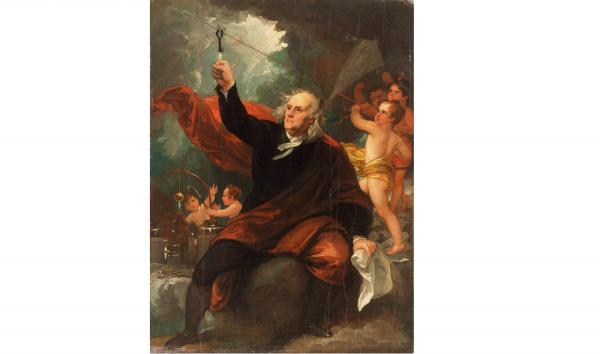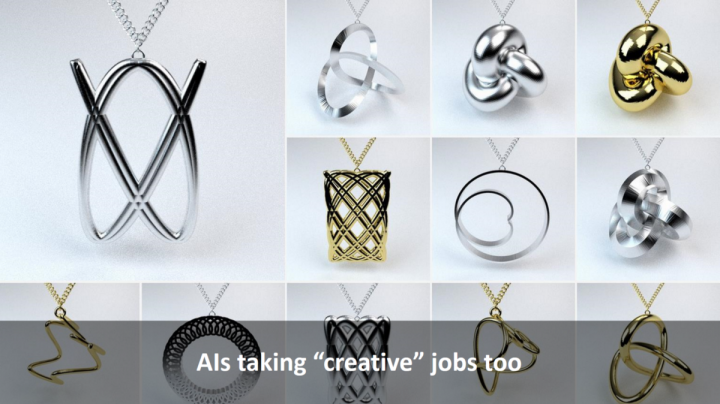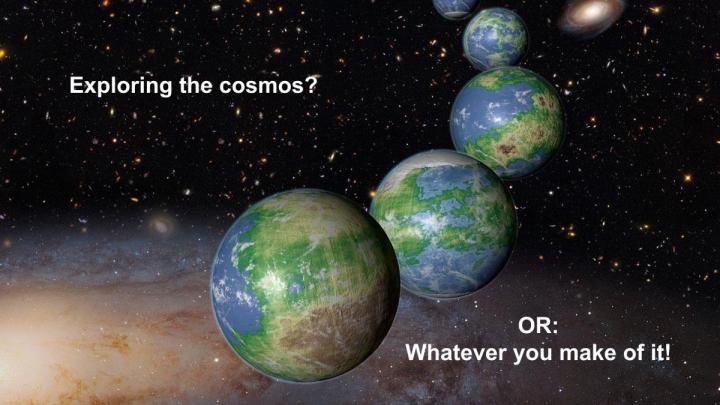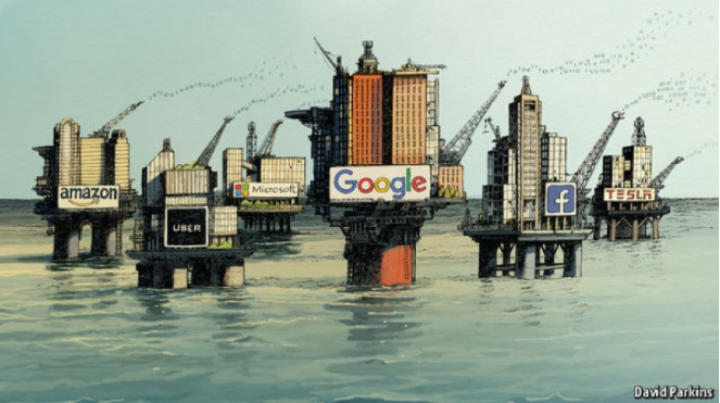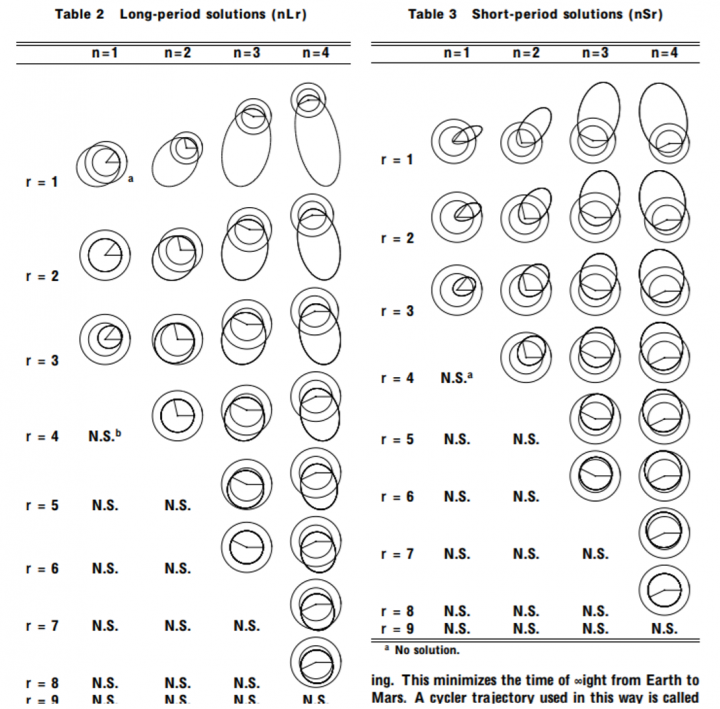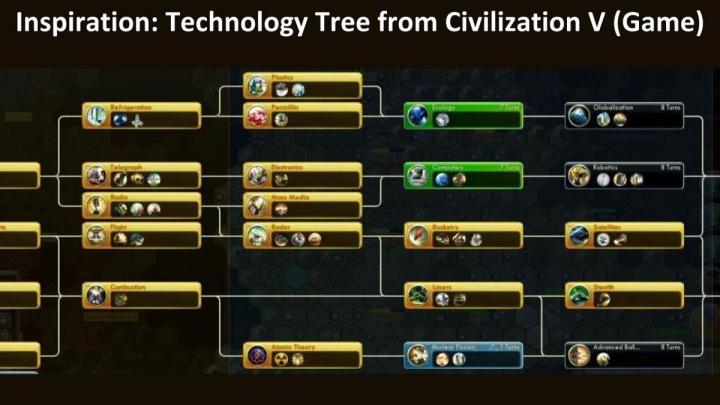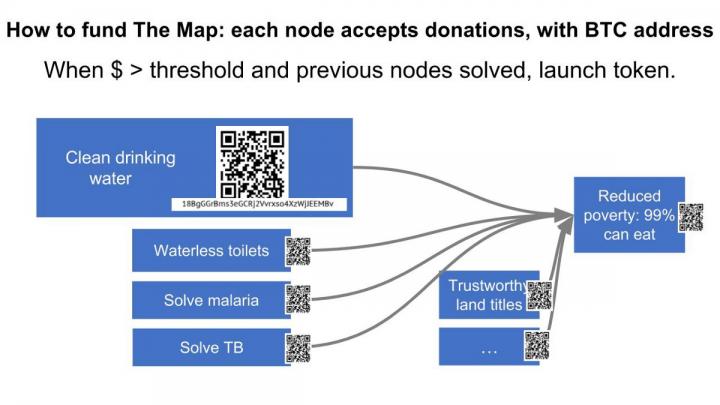Starships and Tokens; A Path to Human Self-Actualization
Many humans don’t settle for just barely scraping by; they improve themselves towards self-actualization. Could we do the same at the level of civilization? Rather than merely avoiding disasters, let’s truly reach for the stars.
In this essay, I describe a decentralized system for humanity to collectively graph the steps towards self-actualization, from conquering malaria and a shared planetary database, to universal basic income and even asteroid mining.
Many humans don’t settle for just barely scraping by; they improve themselves towards self-actualization. Could we do the same at the level of civilization? Rather than merely avoiding disasters, let’s truly reach for the stars.
In this essay, I describe a decentralized system for humanity to collectively graph the steps towards self-actualization, from conquering malaria and a shared planetary database, to universal basic income and even asteroid mining.
But vision is not enough. We need execution, and the resources to power it. There’s a new tool: the blockchain token launch. It’s a low-friction way for a community of aspirational thinkers to fund big ideas with big dollars, and to benefit from the success of those ideas. We start with a token launch for the map itself. That in turn propels token launches for the first steps of the map, which in turn propels the second steps, and so on.
Humans
First, let’s talk about humans. We want to meet our basic needs — food, shelter and clothing — but it shouldn’t end there. We want to have security, of our property, security of ourselves, and ultimately we want to self-actualize. Think Maslow’s hierarchy.
Benjamin Franklin is my favorite example self-actualization. When young, he was a publisher. He wrote books to sell more, most notably Poor Richard’s Almanack. He also invented The Franklin Stove, so that your stove wouldn’t make your house all smoke. He also invented bifocals. Then he retired from publishing and became a scientist. He turned electricity from a being a mystery into a science, connecting lightning with electricity.
Benjamin Franklin and lightning
Pretty good so far! You might think that’s enough, but in the twilight of his career, he co-invented the United States of America. So, if you’re looking for an example of self-actualization, Benjamin Franklin is the man. Not only that, he wrote what is arguably the very first book on self improvement (and one of my favorite books).
Tokens
Tokens are another building block in my proposal. What are tokens? Well, here’s few stories:
Two years ago, a 20 year old man started a non-profit. It had no product and on the basis of a whitepaper (an idea) it raised $20 million. Now, two years later it’s a $30 billion ecosystem and investors made 1000x. This is Ethereum; and it’s quite remarkable. It’s changing the world.
Another example, just a few months ago, was a start-up, with no product, no customers, and only about five employees, raised money on a $300 million valuation. One week later it was worth 3.5 billion Dollars. This is an organization called Gnosis. It’s remarkable too.
Ethereum and Gnosis above are just two examples, there are hundreds. There’s now raises every day. More than a dozen have raised >$50M. Eos, Tezos and Filecoin have each raised >$200M. Many will fail. But some will succeed. Just like the Web boom of the 90s.
What led to this? It all started with Bitcoin, almost 10 years ago now. For the first time ever, civilization had “electronic gold”: a store of value on a ledger that no single person controls. Bitcoin emerged almost 10 years ago. Since then, its technology — blockchain technology — has evolved into Ethereum, Gnosis and more.
The money-raising events are called ICOs (Initial Coin Offerings). Money is raised at the beginning of the project, like a seed round in a startup. However, it’s selling tokens in this network, which may be tokens for shares (like startups) but they may also be tokens to use computational resources, or for governance, or something else. The community collectively owns these tokens and of course, everyone wants the value to rise, so they work together to raise the value of the ecosystem. It’s like a common good for the community of token-holders.
Tokens are liquid immediately on these crypto-exchanges. This means there is an “exit” on day 1. This is a fundamental change, as normally investors have to wait until the startup’s exit — acquisition or IPO — which typically takes five or ten years. With tokens, there is an exit immediately. Therefore liquidity is 10,000x. Also, the supply of investment is larger, because the potential investors aren’t just a couple hundred venture capital firms (VCs), but instead the globe. Liquidity and supply are two reasons that there’s so much money flowing in.
There’s a few ways to frame ICOs:
- an IPO, but crowdfunded;
- a Kickstarter, but for real assets or securities; or
- VC investing for the masses.
ICOs are real. This year alone, ICO investment has totaled more than $2 billion. That’s more than all early-stage VC investment combined in the same time frame.
Some Civilization Worries
So, I’ve set the stage in a couple of ways. Maslow’s hierarchy, and tokens. Now, let’s talk a bit about civilization.
As a civilization, we worry about climate change. We worry about nuclear war; although we thought we were past this after the Cold War. We worry about asteroid strikes; they killed the dinosaurs after all.
We also worry about AIs taking our jobs. You might think you’re safe because you’re creative — an artist or a businessman. Actually: you’re not. Creative AIis a reality. For example, the image below shows AI-generated jewelry. I did my PhD on creative AI ten years ago. Creative AI has been around for decades. So all those creative jobs that you think are safe, will go away too. My view is that probably the safest job of all, is that of AI researcher. But I may be biased — maybe my job will be gone too!
Screenshot from Orbimi. Reference: Greg Hornby
These civilization worries are all about trying to avoid disaster. As a civilization, we are focused on the lowest level of Maslow’s hierarchy — barely getting by.
But, there’s another way to think about it. What if we were to aspire for civilization to self-actualize? For our civilization to be like Ben? What would that look like?
What Does Self-Actualization of Civilization *Mean*?
Does it mean perhaps TED talks for all where we can all talk about self-actualization and pat ourselves on the back? Maybe; but let’s do better, ok?
Maybe it’s about exploring the cosmos. Not just Earth and Mars, but to, say Alpha Centauri and beyond.
Credit: NASA / ESA / G. Bacon (STScI)
And really, civilization self-actualization is whatever you make it. As an individual, maybe I want to do something in science, or maybe I want to do start a company, or write the Great American Novel. We can all can have our own definition of what it means for civilization to self-actualize too.
Also: it’s a series of steps, not just some final goal. That is: civilization’s a journey, not a destination.
So what might those steps look like, in the past and in the future?
Recent Civilization Developments
Lets review some recent developments, to give a flavor of where we’ve come from.
In the last couple decades, we’ve achieved a shared planetary network: that’s the internet (thanks to Vint Cerf and Bob Kahn in the 70s). We’ve achieved a shared interplanetary document, one giant document: that’s the World Wide Web, or just “web” (thanks to Tim Berners-Lee). These are profound technologies. They have massively influenced society, and this was recent.
Now, we have virtual reality, with technologies like Oculus Rift.
We have augmented reality. It’s getting more real these days, with tech like Microsoft HoloLens.
We have big data, for better and for worse. A recent article in the Economist described how data is the new oil. The companies that have amassed the most wealth in the last decade, are the companies that have the data.
Credit: www.economist.com / David Parkins
We have AI. Facebook, Google, and a handful of others of the have the data; and the know-how to convert it to dollars, using AI (deep learning in particular). It works as follows: more data → more accurate model → sell more ads →make more $. Large siloed datasets has become a source of wealth and power.
Some Next Steps for Civilization
We just discussed recent advances for civilization. So, what’s next, in the context of self-actualization of civilization? What might we aspire to? There are a lot of great ideas out there. Let’s explore.
Recalling Maslow’s hierarchy: it’s not just about the very top, it’s about working up the whole hierarchy. The Gates Foundation has done an incredible job, focusing on basic survival needs. The foundation works mainly in Africa not just researching but offering solutions to provide clean drinking water, waterless toilets, solving Malaria, solving Tuberculosis. Besides the Gates Foundation, we have the UN, the World Health Organization, and others.
Others focus on goals from higher in the hierarchy. What if AI really does take 99% of the jobs, does that mean we can’t feed our families? One of the proposals designed to counteract this, is Universal Basic Income, where even if the AI’s take the jobs, we can still feed our families. Albert Wenger writes eloquently about UBI in the context of AI.
Going up even higher, the famous Peruvian economist, Hernando De Soto proposed that if you want to help people rise out of poverty, then you need to give them title to their land. If you’re a poor family in a favela (slum) in Brazil and you can obtain title to that favela, it could be possible to take out a loan, or start a business — to climb out. The challenge in a lot of countries, however, is that no-one trusts the land title registry. This is where companies like BenBen come in, using blockchain technology are implementing trustworthy land registries, that aren’t dependent on the government. Unlock the trustworthy land titles, unlock loans, unlock poverty.
Let’s move onto brain-computer-interfaces. This may sound like science fiction, but people have been working on it since the 80s and before. Once we combine brain-computer-interfaces, EEGs or other methods, with augmented reality goggles, then we can have SMing. That is, silent messaging, texting by simply by thinking about it. So if you combine this with the goggles we talked about earlier, you can think in subtitles to each other. This is pragmatic telepathy. This is possible with today’s technology. Going one step further, is the removal of the bulky goggles and instead using contact lens.
I’ve talked already about Bitcoin, this new development for society with a planetary e-gold, which, you can move around with very little friction. Blockchain technology has been advancing steadily since Bitcoin. There have been many developments since; three core pieces of the infrastructure are:
- A shared planetary file system, to store large data blobs, for example IPFS.
- A shared planetary database for metadata, about which artist created which songs and so on, that’s IPDB+BigchainDB (my day job basically) and
- A shared planetary processing layer — Ethereum. Think computer viruses — but good ones, with wallets attached.

Shared planetary file system, database, processing
This is new, core, internet infrastructure. And, there are more pieces.
We also need to ensure that the masses of data aren’t in the hands of a few ultra-powerful organizations. We need to democratize access to data, while retaining privacy: a data commons of free data, that reconciles with paid data. Ocean Protocol is working on this (also my day job:).
SpaceShipOne. License: CC-BY-SA-3.0
Let’s talk about space. Recall the Ansari XPRIZE of the early 2000s, where the winner was Burt Rutan’s team, with SpaceShipOne. SpaceShipOne provided a solution to low cost to space, and was an amazing technical achievement. However, we’d prefer to have low cost to useful space: getting to orbit. Which is now, finally possible, with the work of SpaceX and their reusable rockets (Falcon 9). This has been the biggest cost factor in space exploration, as rockets would be thrown away. Imagine if, every time you flew between Berlin and London they threw away the plane. Your plane ticket would probably cost a million dollars. This is actually how space travel was, until recently. So it’s a significant advance for humanity.
Looking beyond that we can make it even cheaper, with space elevators. This would basically be a super-long, super-strong string running from Earth to an orbiting satellite. Right now we are not quite there, it’s a materials science problem, but we are getting there.
For civilization, we are very interested in getting to Mars. First of all with one person, but then a thousand and then a million and eventually, so many people, that it really can be independent from Earth. This way, if an asteroid were to hit Earth, civilization would not be wiped out, like the dinosaurs.
Mars! License: public domain
So, civilization survives, but of course we want to get back and forth between Earth and Mars cheaply. How? You could use rocket thrusters, but it turns out that, if you choose just the right trajectory, you can fall to Earth from Mars, (with gravity) loop around Earth and slingshot back to Mars. My brother Troy discovered a whole family of these trajectories, called gravity assist cyclers.
Gravity assist cyclers. From Troy McConaghy et al, Analysis of a Broad Class of Earth-Mars Cycler Trajectories, AIAA, 2002
Why stop at Mars? If we want to go even further beyond, we need energy and raw materials. Asteroid mining can supply both. Planetary Resources and others are pursuing these as full-on businesses.
Let’s talk about exploring the cosmos. There’s a hitch. The next closest sun is Proxima Centauri. It’s 4 light years away. At the maximum speeds of today’s travel flights, it will take 81,000 years to get there. Oops! To quote sci-fi author Charles Stross, “sending canned primates was never going to end happily”. We are basically primates in tin cans. Flying around the cosmos and taking 81,000 years to get there is probably not going to work.
There is a way to explore the cosmos. We might consider migrating our minds into a better substrate. The bio-narcissist in each of us isn’t very happy about this idea. But what does it mean to be human anyway? To me, it’s not about my body per se, it’s about what my mind is experiencing, via the patterns of thought that are manifested in my brain and the rest of my body. There’s no prerequisite that this mind must exist on a biological substrate that breaks down in 100 years. If we migrate to a better substrate, we can explore the cosmos. There are at least two potentially credible ways to migrate our minds to a better substrate.
- There’s uploads. This is a question of brain scanning. The resolution of scans have become significantly better over time; but there is quite a way to go yet.
- Also, there’s the bandwidth++ scenario: think iPhone 25, so once we go beyond the smart phones to when we are talking with texting; and we can keep going.
These won’t going to happen in the next five years, but perhaps 25, 50, or 100 years from now. There’s a bonus: if AI ever did wake up, we’d now have a competitive substrate to deal with it.
Let’s keep going. Why stop with exploring the cosmos? Why not reshape the cosmos? Expand your mind: how big can you dream? What’s the biggest thing that civilization could possibly achieve? Once again, I wish I’d thought of these things myself, but I have to credit sci-fi writers like Charles Stross, who wrote,
Dismantle the moon! Dismantle Mars!
Build masses of free-flying nanocomputing processor nodes…
Matrioshka brains, Russian doll Dyson spheres the size of solar systems.”
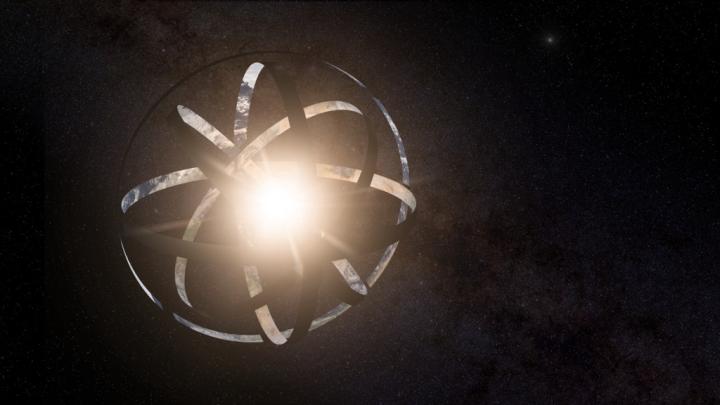
Dyson Sphere, by Kevin Gill (CC-BY-2.0)
We can aim for the cosmos. Dyson Spheres FTW. This is one possible goal; it doesn’t have to be “the” goal. It’s up to each of us, and to our collective goals as a society, as we go forward in the future. We don’t have to decide today or tomorrow, this is just a possible future for civilization. But it’s an exciting possibility!
How Do We *Organize* The Ideas?
If we try reshaping the cosmos tomorrow, we will fail as the technology isn’t there. There are many steps in between. How do we organize the ideas? Video games like Civilization contemplate this. Near the beginning, you invent fire; then the wheel; that unlocks the steam engine; and so on, with each invention taking civilization further. This is all organized in a “technology tree”, a directed graph that maps out technology developments.
Credit: Sid Meier’s Civilization® V
Imagine if we took this concept, not just for a video game, but for civilization itself. That’s what I do here. I will now a starting point map, a piece at a time; but note now that this is just a starting point for all of society to improve upon.
Mapping Out Civilization Ideas
I talked about reducing poverty. One goal is: 99% of people on the planet can eat. What does it take to get there? The Gates Foundation targets lean drinking water for all, waterless toilets, solving Malaria, solving TB and of course more things. That’s really just for the lowest level in Maslow’s hierarchy. One level up, it’s things like trustworthy land titles. Once we get past a few of these, we get to that level where 99% of the population of the planet can eat.

Let’s riff on this graph, and bring in the challenge of AI: if AI takes all of our jobs, the 99% suddenly have no income and can’t eat. Oops! That would cause major social upheaval.

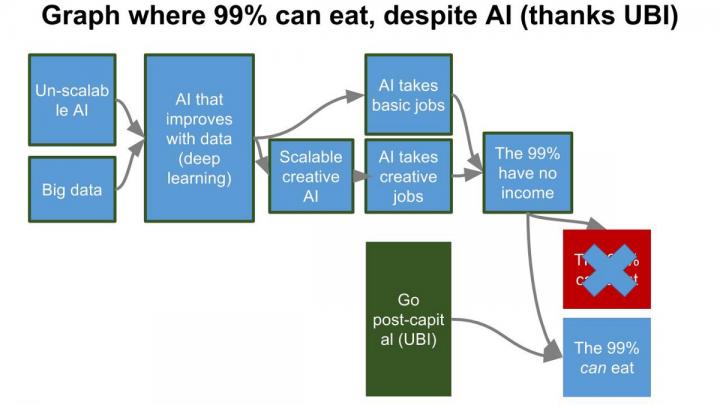
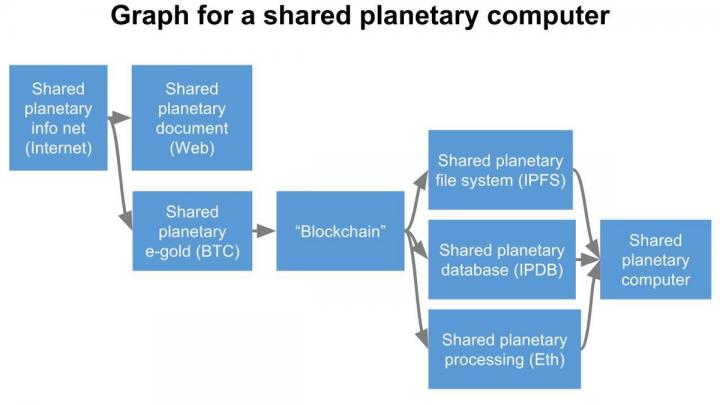
There’s at least one hitch: If you want to have a substrate for the mind, do you want to host it on Amazon? Probably not. You probably don’t want to be reliant on Jeff Bezos pulling the plug, or Elon, or anyone for that matter. You really need something, that’s out there, that no single entity owns or controls. That is, a shared planetary computer. We make this an additional input to the “new mind substrate” node.
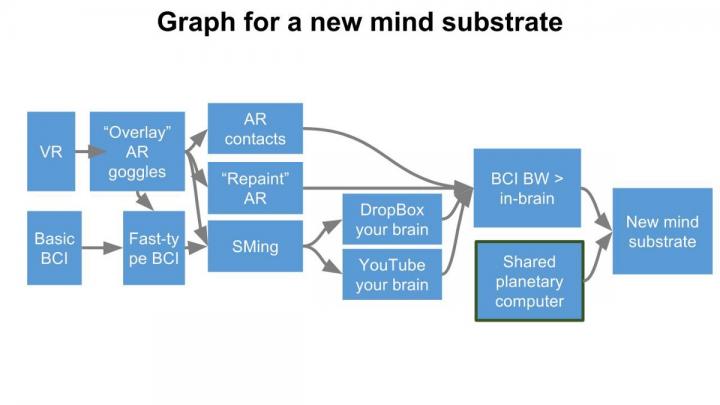

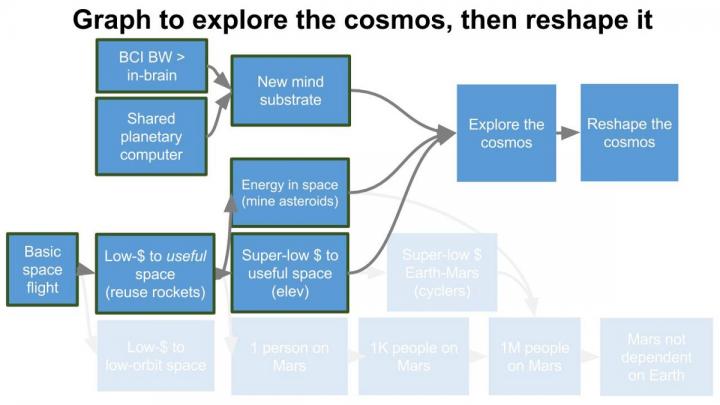
This is just a starting point. I don’t have most of the ideas. But here’s a trick: crowdsource the ideas. Put it this graph onto the web, onto this “shared document” substrate and allow other people to contribute.
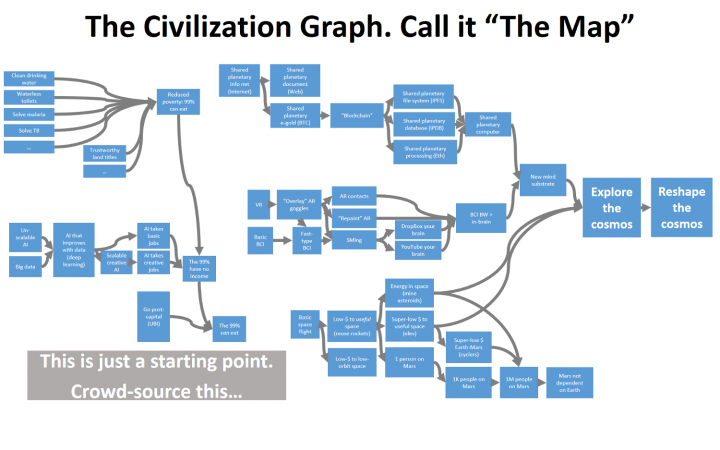
How Do We *Pay* For The Ideas?
So, you might think, ‘well this is all great, Trent, great, cool ideas, kind of crazy’.
But… wouldn’t it be wonderful if we could achieve that?
You might ask, how? Well, how are these big ideas normally funded? Wikipedia takes regular donations; and then uses the funds to keep the lights on and grow. Or you can get donors and then give prizes. That actually turns out to be a 10x lever on the money, and this is what XPRIZE Foundation has done.
Or, you could make a lot of money, that is, become a billionaire, and then give most of it back, like Bill and Melinda Gates’ foundation is doing. I’ve previously asked myself how I might get super rich, so that I can give it all away. But I’ve also asked myself, is there another way?
There are issues with some of these existing approaches.
- So far, we’ve only been tapping into a very small community and so, few benefit.
- It’s relatively small amounts of money, because it’s all donations. So it’s a money sink more than an investment opportunity. If, however it were an investment opportunity, a lot more money could flow.
- Work is incentivized for only one step out, not multiple steps. People don’t have the context of what they’re funding, it’s only the first step.
To address these issues, we have a new tool: tokens. Think of tokenized ecosystems as public utilities. A shared infrastructure for file storage and for databases and so on. So far it’s only been for internet infrastructure, like e-gold for bits. But it could also be about atoms, there’s nothing stopping us from tokenizing hyperloop for Europe, crowdfunding a hyperloop for Europe or crowdfunding asteroid mining.
So, we have this idea of tokens as public utilities, what does that look like? Well, imagine we have this map online that people can explore, add ideas, but now imagine every single point on that map has a Bitcoin address and with that Bitcoin address it’s super easy for people to donate to. So, say I put in 10 Euros, someone else puts in €1000, someone else says hey, this is a great idea, I’ll put in a million. Once you get past a certain threshold, say $5 million, a team gets assembled and actually goes for it. It completes a full on token launch, launch a company, launch an ecosystem. (This is just one variant. I’ve been exploring several others. More on this in later writings.)
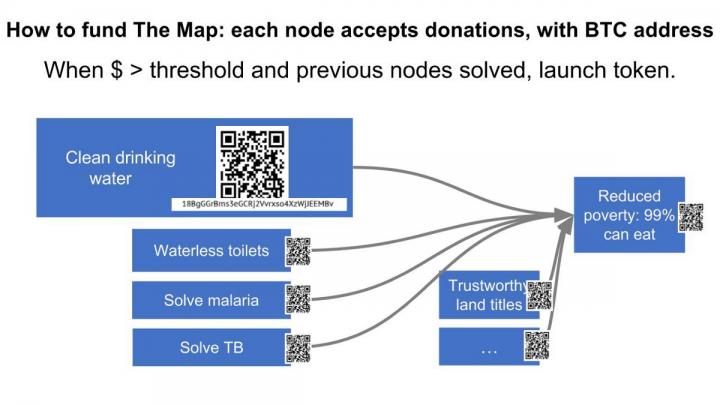
Here’s the amazing thing :
Tokens fund the self-actualization of civilization
Here are the benefits:
- Tokens tap into the community that wants the advance
- There can be significant money flowing in because it’s an investment opportunity, not a charity
- It helps to prioritize ideas, even long-term ideas, via money. Even the furthest away things on the map, people can vote with dollars. You don’t want it to be only money based priorities, but it helps.
- It’s easy to tell where the money leads, in context of the graph
Conclusion
The Map helps civilization to self-actualize. It comes in two pieces:
- It’s got a crowdsourced idea graph, you’ve got an online graph that people can contribute to. And,
- It’s funded by tokens. Tokens like Ethereum or Bitcoin and beyond.
I think this is cool, because it not only addresses climate and jobs and AI, it leads us to exploring and reshaping the cosmos. To summarize in one picture:
Related Stories
- Part I: Tokenize the enterprise [post]
- Part II: Tokenize bits, and atoms [post]
- Part III: Starships and tokens — a path to human self-actualization: tokenize civilization [this post]
Other Media
Here’s the video of the Convoco talk (May 2017, Salzburg).
Here are the slides from the Innogy UnConference talk (Sept 2017, Berlin).
### Acknowledgements
(Note: this essay is based on a talk I gave at Convoco Forum [(https://vimeo.com/228366361)][[slides](https://www.slideshare.net/TrentMcConaghy/starships-and-tokens-a-path-to-human-selfactualization)], and at Innogy Machine Economy UnConference [[slides](http://trent.st/content/20170928%20innogy%20-%20starships%20and%20tokens.pdf)], both in mid 2017)
Thanks especially to the following people for inspiring conversations that led to this post (and the related talks). Greg McMullen, Anish Mohammed, Albert Wenger, Simon de la Rouviere, Eric Anderson, Amir Banifatemi, Masha McConaghy, and Bruce Pon.
And, thanks to Corinne and the folks with Convoco Forum 2017; and Caroline and the folks with Innogy Machine Economy UnConference 2017 for the opportunity to present these ideas as keynotes:)
If I forgot you, sorry! Please email me and remind me. I’m still waiting for that perfect memory upgrade:)

Don’t miss out – Find out more today

